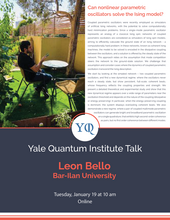Event time:
Tuesday, January 19, 2021 - 10:00am to 11:00am
Audience:
Postdoctoral Associates
Location:
Zoom
Event description:
Can nonlinear parametric oscillators solve the Ising model?
Coupled parametric oscillators were recently employed as simulators of artificial Ising networks, with the potential to solve computationally hard minimization problems. Since a single-mode parametric oscillator represents an analog of a classical Ising spin, networks of coupled parametric oscillators are considered as simulators of Ising spin models, aiming to efficiently calculate the ground state of an Ising network - a computationally hard problem. In these networks, known as coherent Ising machines, the model to be solved is encoded in the dissipative coupling between the oscillators, and a solution is offered by the steady state of the network. This approach relies on the assumption that mode competition steers the network to the ground-state solution. We challenge that assumption and consider cases where the dynamics of coupled parametric oscillators transcend the Ising description.
We start by looking at the simplest network – two coupled parametric oscillators, and find a new dynamical regime, where the oscillators never reach a steady state, but show persistent, full-scale, coherent beats, whose frequency reflects the coupling properties and strength. We present a detailed theoretical and experimental study and show that this new dynamical regime appears over a wide range of parameters near the oscillation threshold and depends on the nature of the coupling (dissipative or energy preserving). In particular, when the energy-preserving coupling is dominant, the system displays everlasting coherent beats. We also demonstrate a new regime, where a pair of coupled multimode parametric oscillators can generate bright and broadband parametric oscillation on a single quadrature, that exhibits high second-order coherence as pairs, but no first order coherence between different modes.
We then continue to explore the coherent dynamics in a small network of three coupled parametric oscillators and demonstrate the effect of frustration on the persistent beating between them. We theoretically analyze the dynamics and corroborate our theoretical findings by a numerical simulation that closely mimics the dynamics of the system in an actual experiment. Our main finding is that frustration drastically modifies the dynamics. While in the absence of frustration the system is analogous to the two-oscillator case, frustration reverses the role of the coupling completely, and beats are found for small energy-preserving couplings.
Finally, we study large networks of parametric oscillators as heuristic solvers of random Ising models. By considering a broad family of frustrated Ising models, we instead show that the most efficient mode generically does not correspond to the ground state of the Ising model. We infer that networks of parametric oscillators close to threshold are intrinsically not Ising solvers. Nevertheless, the network can find the correct solution if the oscillators are driven sufficiently above threshold, in a regime where nonlinearities play a predominant role. We find that for all probed instances of the model, the network converges to the ground state of the Ising model with a finite probability.
Zoom link (Requires Yale CAS): https://yale.zoom.us/j/94244387054
